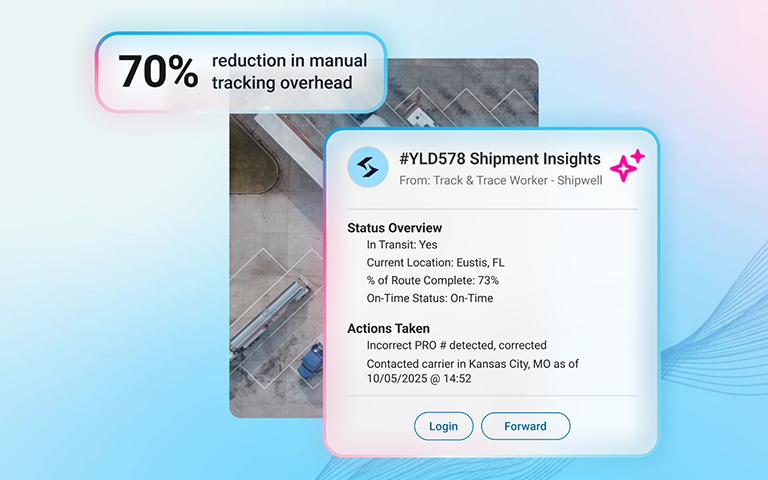Navigating the AI Craze for Shippers

Logistics powers global economies, with route optimization, supply chain visibility, and demand forecasting already being shaped by artificial intelligence in transportation operations. But the real challenge isn’t finding AI tools, it’s finding the right ones for the problems you need to solve.
Why Artificial Intelligence in Transportation & Logistics Matters
It wouldn’t be logistics without tight margins, constant disruptions, and the need for real-time visibility, and that’s where AI is stepping up to aid shippers. Choosing the best AI solution can help solve logistics’ most pressing challenges—improving efficiency, lowering costs, and enhancing service quality. Emphasis on ‘the best’: according to a recent MIT report, only about 5% of AI initiatives achieve the financial benefits initially promised… and that success is determined almost entirely by approach. The key is distinguishing between ‘shiny-object AI’ and practical AI that actually drives ROI.

At Inland Academy, I shared a straightforward framework for evaluating and adopting AI in transportation and logistics. My session “Navigating the AI Craze for Shippers,” focused on:
- Separating fact from fiction: Identifying practical, high-impact AI applications that solve real problems, not just hype.
- Responsible, strategic deployment: Focusing on use cases that deliver measurable ROI for shippers.
- Looking ahead: Understanding where AI is headed and how logistics leaders can start leveraging it today.
A Practical Framework for AI in Logistics
To paraphrase Spider-Man: “with great power comes great responsibility”: AI is a mighty tool to manage logistics operations, but using AI comes with a special set of considerations. Shippers manage highly sensitive data—pricing, contracts, customer information—so protecting that data is non-negotiable. Responsible AI adoption is a strategic imperative that builds trust and resilience as much as it is a compliance checkbox.
Key Principles for Responsible AI in Logistics:
- Data Privacy and Security: Every AI initiative must start with secure data handling. Shippers should demand robust privacy protections and ensure that sensitive information is never exposed or misused.
- Governance and Guardrails: Set clear policies for how AI is trained, deployed, and monitored. This includes vendor due diligence, regular audits, and transparent processes for updating or retraining AI models.
- Human-in-the-Loop: AI should augment human expertise, not replace it. Keeping people in the decision-making loop ensures that critical judgment and industry knowledge remain central to logistics operations.
- Transparency and Explainability: AI systems should be understandable and their actions explainable. This builds confidence among users and stakeholders, and helps identify and correct errors or biases.
- Accountability: Assign clear roles and responsibilities for AI oversight. If something goes wrong, there should be a defined process for investigation and remediation.
- Fairness and Inclusiveness: AI must treat all stakeholders equitably and avoid introducing or amplifying bias.
How to Get Started with AI in Logistics
Audience questions centered on how to begin the AI journey. Here’s a step-by-step approach:
- Assess current processes: Identify data-intensive, repetitive, or error-prone tasks that could benefit from AI.
- Evaluate risks and rewards: Consider cost savings, efficiency gains, customer impact, and data security.
- Review technology platforms: Ensure your current systems can support AI integration.
- Clean and organize data: High-quality, accessible data is essential for successful AI adoption.
- Start small: Pilot AI in a focused area, measure results, and scale successful implementations.
- Scale only those that succeed: Once you’ve validated your pilot, begin to scale across your organization. Note any lessons learned to guide this expansion.
How is Shipwell’s AI Different?
Shipwell has responsible AI integrated directly into its Transportation Management System (TMS), meaning there are no steep learning curves or risky integrations. Just proven, secure AI that gets real results that empower shippers to:
- Maintain real-time visibility from order to final mile
- Optimize decisions with predictive insights
- Reduce operational strain while improving accuracy
Through conversational AI, agentic workers, and configurable AI workflows, Shipwell customers can automate routine tasks, streamline exception management, and focus their teams on higher-value work.
Track & Trace AI Worker: Configurability and Communication
One of the most discussed features during the session was the configurability of Shipwell’s Track & Trace AI Worker. Shippers can tailor communication channels—choosing between email, SMS, or other methods—and set outreach frequency and timing for different stakeholders.
This flexibility ensures that updates reach the right people, at the right time, through the preferred channel, all while maintaining a complete audit trail of AI actions. The system can be configured to only send communications during business hours, and users can define which carriers or shipments the AI should monitor, giving shippers full control over automation parameters.
In-App AI Assistant: Instant Answers and Action
Shipwell’s In-App AI Assistant is redefining how logistics teams interact with their TMS. This intelligent assistant uses advanced natural language processing to answer complex logistics questions, deliver actionable recommendations, and guide users through critical workflows—all in real time, right where the work happens.
By embedding this assistant directly into the Shipwell platform, Shipwell ensures that logistics professionals of all experience levels can leverage AI to streamline daily operations, reduce manual effort, and unlock new levels of efficiency. It’s a smarter, more intuitive way to manage supply chains—one conversation at a time.
Key Takeaways from the Inland Distribution Conference
After my speaking session, I had the opportunity to attend the Inland Distribution Conference in the days following. Myself, alongside other shippers, transportation and logistics providers, 3PLs, equipment providers, and port operators, listened in on economic updates and discussed operational outlooks for logistics, with highlights being:
- Economic Trends: GDP growth slowed to 1.6% in 2025, with a rebound expected in 2026. Freight demand remains weak compared to previous years, and effective US tariffs are holding steady at 19-20%, up from 3% in the 2010s. The oil industry faces recession risk, and industrial production has not fully recovered.
- Intermodal and Trucking: Intermodal volumes peaked earlier than usual in 2025, with rates remaining flat. Over 120 new industrial projects have been announced, expected to drive a truckload (TL) freight uplift in 2026. Carriers are focused on reducing hard costs, with $120-140 per hour as the benchmark for full truckload operations.
- Market Sentiment: Q4 is expected to be soft, with mixed opinions on a Q1 rebound. Carriers and brokers are stretched thin, feeling the effects of a prolonged “freight recession.” There is a strong emphasis on partnership between shippers and carriers to manage costs and maintain service levels.
- Financial Outlook: Anticipated Federal Reserve rate cuts and a potential drop in the 10-year treasury below 4% could inject more liquidity into the economy, especially as refinancing activity picks up.
- Industry Challenges: Shippers are pushing to keep freight rates low, while large 3PLs discuss layoffs and operational efficiency. The focus is on collaboration, cost control, and leveraging technology to weather ongoing volatility.
Leaders Who Use AI Will Replace Those Who Don’t
AI is not about replacing logistics leaders—it’s about equipping them with the tools to solve problems smarter and faster. The future belongs to those who adopt AI responsibly, starting with small wins and scaling with confidence. At Shipwell, we’ve seen firsthand how even a focused pilot project can free up your team’s time and deliver measurable results within weeks.
Need help finding that starting point? We can help you define a pilot that fits your goals, your data, and your team’s workflow and build a roadmap that’s practical, responsible, and tailored to your business. Request a demo to learn more.
FAQs
How can logistics leaders get started with AI?
Start by identifying repetitive, data-heavy processes that are prone to errors. Pilot AI in one area, measure the impact, and scale successful solutions. Ensure your data is clean and your technology stack can support AI integration. See the “How to Get Started with AI in Logistics” section above for a step-by-step guide.
What are the biggest economic challenges facing logistics in 2025?
Slowed GDP growth, weak freight demand, high tariffs, and ongoing cost pressures are top concerns. Carriers and brokers are focused on cost control and partnership, while shippers are leveraging technology to maintain service levels and manage volatility. See the “Key Takeaways from the Inland Distribution Conference” section for more details.
What’s the difference between automation, AI workflows, and AI agents?
- Automation: Executes predefined, rule-based tasks.
- AI Workflows: Integrate large language models for flexible, deterministic tasks.
- AI Agents: Perform adaptive, autonomous tasks with human-like reasoning. Shipwell combines all three to optimize logistics operations .
How does Shipwell ensure responsible AI adoption?
Shipwell prioritizes data privacy, human oversight, transparency, and ethical guidelines. AI augments human decision-making, not replaces it, and all actions are auditable and configurable by the user. See the “Practical Framework for AI in Logistics” section for more.
How configurable is Shipwell’s Track & Trace AI Worker?
Shipwell’s Track & Trace AI Worker allows shippers to customize communication channels (email, SMS, etc.), outreach frequency, and timing for each stakeholder group. Users can define which carriers or shipments the AI should monitor and set business-hour restrictions, ensuring updates are delivered efficiently and according to operational preferences.
What are the most common use cases for AI in logistics today?
AI is delivering value in route optimization, demand forecasting, real-time shipment visibility, exception management, document handling, and compliance checks. These applications help shippers reduce manual work, improve accuracy, and respond faster to disruptions.
What risks should logistics leaders consider when adopting AI?
Key risks include data privacy breaches, algorithmic bias, and over-reliance on black-box models. Leaders should implement secure data handling, conduct vendor due diligence, and maintain human-in-the-loop decision-making to mitigate these risks.
How can shippers measure the ROI of AI initiatives?
Track metrics such as time saved per order, reduction in manual tasks, improved on-time delivery rates, and cost savings from process automation. Start with pilot programs and use clear KPIs to evaluate impact before scaling.
What skills or team structure are needed to implement AI in logistics?
Successful AI adoption requires a mix of domain expertise, data science, and technology skills. Building a diverse team and providing ongoing training ensures effective implementation and continuous improvement.
How quickly can shippers expect to see results from AI pilots?
Most organizations see measurable improvements—such as time savings and error reduction—within the first few months of a well-scoped pilot. The key is to start small, monitor results, and iterate based on feedback.
What’s next for AI in logistics over the next 1-3 years?
Expect to see AI copilots and assistants become standard, predictive and prescriptive supply chains, and more autonomous decision-making. The focus will shift from manual execution to strategic oversight and continuous improvement.


.svg)








